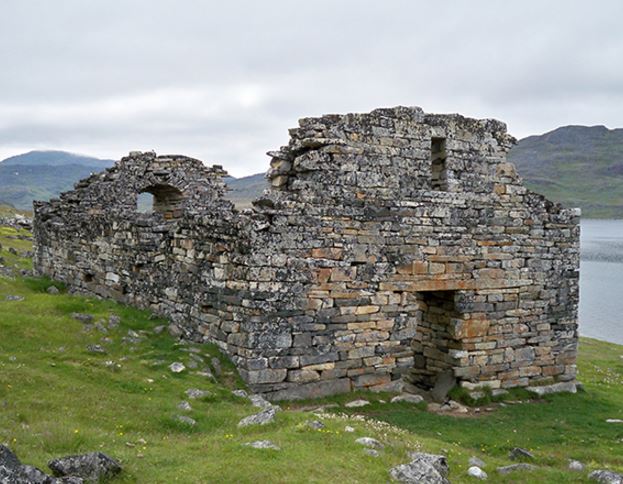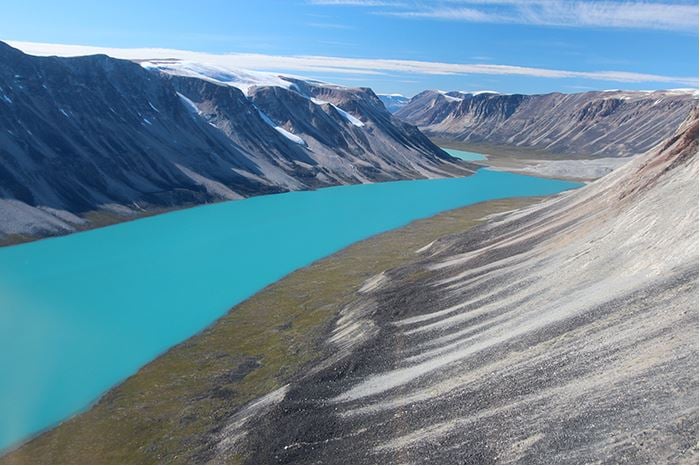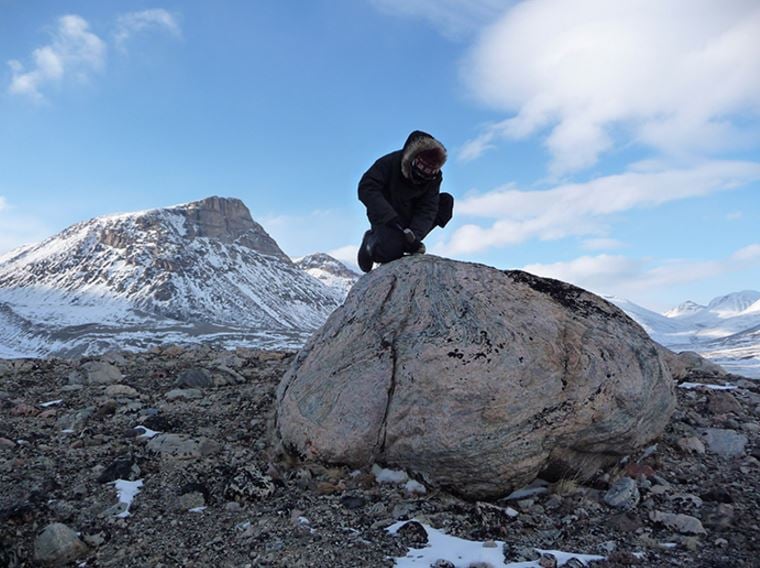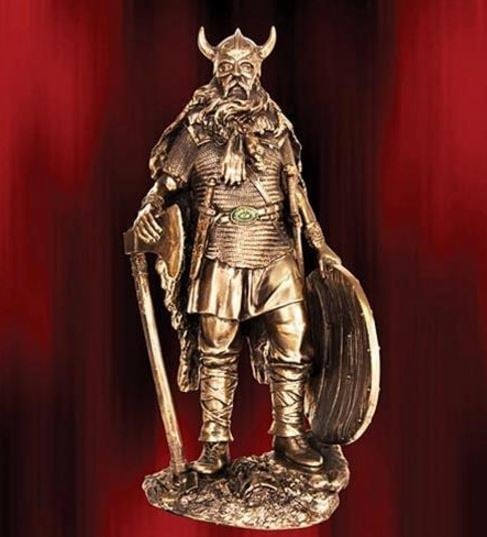The belief that 10th-century Vikings were driven or encouraged to colonize Greenland because of unusually warmer weather is probably wrong – the climate was already cold when the Norse got there – say researchers at Columbia University in New York City.
By analyzing old glaciers, the scientists wrote in the academic journal Science Advances that the weather was already cold when the Vikings arrived. They do not believe the climate had anything to do with their mysterious disappearance 400 years later.
This study adds to growing evidence that the so-called Medieval Warm Period, when the weather in Europe was exceptionally clement – from about 950 to 1250 AD – may not have spread to other parts of the world, as many historians and scientists have suggested.
 The Vikings colonized Greenland, and perhaps neighboring Baffin Island too, during what has been assumed to be – maybe mistakenly – a temporary warm period. They vanished in the 1400s. Southern Greenland’s Hvalsey church (picutred above) is the best preserved Viking ruin. (Image: earthinstitute.columbia.edu. Credit: Wikimedia Commons)
The Vikings colonized Greenland, and perhaps neighboring Baffin Island too, during what has been assumed to be – maybe mistakenly – a temporary warm period. They vanished in the 1400s. Southern Greenland’s Hvalsey church (picutred above) is the best preserved Viking ruin. (Image: earthinstitute.columbia.edu. Credit: Wikimedia Commons)
Medieval Warm Period was probably not uniform nor global
Lead author, glacial geologist Nicolás Young, who works at Columbia University’s Lamont-Doherty Earth Observatory, said:
“It’s becoming clearer that the Medieval Warm Period was patchy, not global. The concept is Eurocentric – that’s where the best-known observations were made. Elsewhere, the climate might not have been the same.”
Climate researchers have cited the Medieval Warm Period (MWP), also known as the Medieval Climate Optimum or Medieval Climatic Anomaly, to explain unusual rainfall patterns and temperatures in far-flung regions, from China to the American Southwest.
The Vikings, led by Erik Thorvaldsson (950 – c. 1003), also known as Erik the Red, first sailed from Iceland, where they had recently settled, to southwestern Greenland around 985 AD, so Icelandic records say.
Between 3,000 and 5,000 Vikings eventually settled in Greenland, raising livestock and harvesting walrus ivory. However, between about 1360 and 1460 they disappeared, leaving just some ruins, and a long-standing mystery as to what happened to them.
While the native Inuit remained, it was not until the 1700s before the Europeans re-inhabited Greenland.
The Greenlandic Vikings’ apogee coincided with the Medieval Climatic Anomaly, and their demise followed the onset of the Little Ice Age (1300-1850).
 Glaciers generally recede during warm times and advance during cold ones. These two, in western Greenland, are currently retreating from where they may have been when the Vikings arrived. (Image: earthinstitute.columbia.edu. Credit: Jason Briner)
Glaciers generally recede during warm times and advance during cold ones. These two, in western Greenland, are currently retreating from where they may have been when the Vikings arrived. (Image: earthinstitute.columbia.edu. Credit: Jason Briner)
Both periods are clearly documented in Icelandic and European historical records. That is why many authors and number of scientists believe that the warmer climate spurred the Vikings to Greenland, and then the the bad weather that followed brought about their demise.
Several other factors could have caused the Greenland Vikings’ demise
The problem is there are no early historical climate records from Greenland. Historians have suggested more recently that perhaps more complex factors, instead of or in addition to the climate, may have contributed to their disappearance, including hostilities with the Inuit, soil erosion caused by the cattle they imported, a migration back to European farms that had been depopulated by the Black Plague, or a decline in ivory trade.
In this new study, the researchers sampled boulders left by advancing glaciers over the past 1,000 or so years in southwest Greenland, as well as on neighbouring Baffin Island, which the Vikings may have occupied too, according to newly uncovered evidence.
Most evidence of where the glaciers were during the Viking settlement has been wiped out by glacial advances during the Little Ice Age.
But Professor Young and colleagues were able to find traces of a few moraines – masses of rocks and sediment carried down and deposited by glaciers – that by their layout, they could determine predated the Little Ice Age advances.
 Small outlet glaciers are wasting backward in western Greenland, leaving behind piles of rocks (moraines) that mark their previous advances. Meltwater has formed a lake. (Image: earthinstitute.columbia.edu. Credit: Jason Briner)
Small outlet glaciers are wasting backward in western Greenland, leaving behind piles of rocks (moraines) that mark their previous advances. Meltwater has formed a lake. (Image: earthinstitute.columbia.edu. Credit: Jason Briner)
They used newly precise methods of analyzing chemical isotopes in the rocks, and found that these moraines had been deposited while the Vikings were living there, and that the glaciers had either neared or reached their maximum Little Ice Age positions between 975 and 1275.
It was probably cold in Greenland when the Vikings arrived
This suggests that it was at least as cold in Greenland when they first arrived as when they left. If this was the case, it makes no sense that they left because of the cold, if it was cold when they arrived.
Prof. Young said:
“If the Vikings traveled to Greenland when it was cool, it’s a stretch to say deteriorating climate drove them out.”
The findings fit with other evidence developed recently showing that the effects of the Medieval Warm Period were not the same everywhere. In some regions, including northwestern North America and parts of central Eurasia, temperatures may have dropped.
 In Baffin Island’s Naqsaq Valley, Jason Briner, a University at Buffalo geologist, samples a boulder left by a glacier around the time of early Viking settlement. Measurements of chemical isotopes within the rock suggest settlers in neighboring Greenland experienced cold weather. (Image: earthinstitute.columbia.edu. Credit: Nicolás Young)
In Baffin Island’s Naqsaq Valley, Jason Briner, a University at Buffalo geologist, samples a boulder left by a glacier around the time of early Viking settlement. Measurements of chemical isotopes within the rock suggest settlers in neighboring Greenland experienced cold weather. (Image: earthinstitute.columbia.edu. Credit: Nicolás Young)
A 2013 study of ocean-bottom sediments suggests that temperatures in the western North Atlantic actually declined while the eastern North Atlantic got warmer. Other studies of the region point to a more complex picture.
A study carried out in 2011 of a core from the Greenland ice sheet shows temperatures dropped steeply at the start of the Viking occupation, and then again in the middle, with interspersed warming.
Another study, carried out by Lamont-Doherty paleoclimatologist William D’Andrea in 2011 of lake-bottom sediments, suggested it may indeed have been warm when the Vikings arrived, but temperatures started to drop in 1160, well before the Little Ice Age.
This new study may encourage scientists who suggest that the Medieval Warm Period was partly just an extended phase of the North Atlantic Oscillation (NAO).
Current observations show that NEO is typically a decadal-scale climate cycle, in which warm winds from the west gather strength and push up temperatures in Europe and Iceland, but at the same time make Baffin Island and southwest Greenland cooler, by sucking in more air from the Arctic. That makes the two regions’ temperatures see-saw in opposite directions.
 A statue of Erik the Red, the fierce red-haired Viking, who is remembered in medieval and Icelandic saga sources as having founded the first Norse settlement in Greenland. (Image: museumreplicas.com)
A statue of Erik the Red, the fierce red-haired Viking, who is remembered in medieval and Icelandic saga sources as having founded the first Norse settlement in Greenland. (Image: museumreplicas.com)
A ‘coup de grace’ on the Medieval Warm Period
Paleoclimatologist Gifford Miller, who works at the University of Colorado, called the paper ‘a coup de grace on the Medieval Warm Period.’
Prof. Miller, a Fellow and Associate Director of INSTAAR, said the study shows:
“With great clarity of evidence (that) the idea of a consistently warm Medieval period is certainly an oversimplification and of little utility.”
Climate historian Astrid Ogilvie, currently based at the University of Akureyri (Háskólinn á Akureyri), said that the study “shows that the climate is clearly more complicated and variable than people earlier assumed.”
Prof. Ogilvie added:
“I do not like the simplistic argument that the Greenland people went there when it was warm, and then ‘it got cold and they died’. I think the Medieval Warm Period has been built on many false premises, but it still clings to the popular imagination.”
The rocks were studied at the Lamont-Doherty laboratory of geochemist and study co-author Joerg Schaefer, and at the University of Buffalo. The Lamont lab is one of very few that is able to precisely date such recent rock deposits.
The scientists measured build-ups of tiny amounts of Beryllium 10, an isotope created when cosmogenic rays hit rock surfaces newly exposed to melting ice.
Citation: “Glacier maxima in Baffin Bay during the Medieval Warm Period coeval with Norse settlement,” Nicolás E. Young, Avriel D. Schweinsberg, Jason P. Briner and Joerg M. Schaefer. Science Advances, Vol. 1, no. 11, e1500806. 4 December, 2015. DOI: 10.1126/sciadv.1500806.
